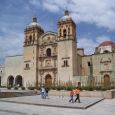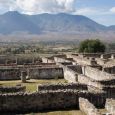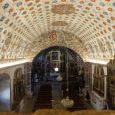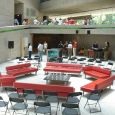Oaxaca
Advertisement
By Bus
Bus line ADO has different classes of busses: You can also use the Ticket Bus service for buying tickets to and from Oaxaca
By Car
From Mexico City take toll road 150 to Puebla ; continue on the Autopista Puebla Cordoba150-0 (toll road), until you reach the intersection with the Superhighway Cuacnopalan-Oaxaca, and continue on this road until you reach Oaxaca City .
By Train
Oaxaca has two places declared by UNESCO as belonging to the Cultural Heritage of Mankind: the archaeological site of Monte Albán and the Centro Historico of Oaxaca City. These prehispanic and colonial riches are without compare in Mesoamerica.
Advertisement
Iglesia de Santa Domingo
The splendid Iglesia de Santo Domingo, a Dominican church founded in 1575, is situated five blocks north of the main square. The church and the adjoining convent, built with 2m (6.5ft)-thick walls to make it almost completely earthquake-proof, cover an area of 150 m (492 ft) 3 150 m (492 ft). There are numerous niches filled with statues in the impressive Baroque façade.
The walls and ceiling of the church interior, which dates partly from the 18th c., enjoy a wealth of gilded ornamentation and bright sculptures in high relief, which stand out brilliantly against the white background.
The overall impression is more of a palace than a church. The rustic style of the coloured statues lend the nave, choir arch and chapels a distinctive Mexican note. On the ceiling above the entrance can be seen a vine, from whose golden branches and leaves grow 34 portraits. These depict the family tree of St Domingo de Guzmán, the founder of the Dominican order who died in 1221 and who was related to the royal familes of Spain and Portugal.
Of the eleven different chapels the largest and most beautiful is the Capilla de la Virgen del Rosario (Rosary Chapel). It has its own choir, a sacristy and even a number of towers.
The lavishly-decorated altar with a figure of the Virgin Mary is considered a jewel of Mexican Rococo.
The majority of the church's original altars and decorations were destroyed in the 1960s when it was temporarily transformed into a stable. Later restoration work was based on the originals.
Mercado Benito Juarez
Just one block south of Zócalo a daily market (Mercado Benito Juárez) is held in the old market building. Like most of Oaxaca's markets it is very colourful. On Saturdays, when the Indios flock here from all directions, it becomes even livelier; goods on sale include woven articles, earthenware, leatherware, knives and machetes.
Another colourful market is the Mercade de Abastos (mainly foodstuffs) held daily on a site south-west of the town centre; it, too, is especially lively on Saturdays when the Indios come in from the surrounding villages. A third market worth a visit if the Mercado de Artensanias south of Benito Juárez market, which specialises in textile goods.
Huijazoo
North-west from San José Mogote along the MEX 190 is the small town of Huijazoo. Shortly behind the town a turning to the left leads over railway lines to the excavation site of Huijazoo (Náhuatl: "in the war fortress") where nine tombs were discovered.
The most remarkable of these tombs is Tomb 5 which lies beneath a pyramid not yet examined A serpent mask forms the entrance to this tomb, whose interior is furnished with sculptured columns and coloured murals. It is thought that these frescos, which depict rulers or priests, date from the 8th to 10th c. ad and are of Zapotec origin. The architecture and painting are unique for this part of the country.
Tlacochahuaya
A further 10km/6mi from Santa María del Tule a turning to the left leads to the nearby town of Tlacochahuaya with the 16th c. San Jerónimo Church.
The colourful paintings inside the church are original. Indians portrayed their artistic and religious ideas here in a highly original way by covering the walls with stars, flowers, birds, suns and angels.
Rufino Tamayo Museum
The Museo de Arte Prehispánico Rufino Tamayo (Rufino Tamayo Museum), a gift to the state from the famous Mexican artist Tamayo, is housed in a palace on the Av. Morelos (no 503), four blocks away from Zócalo. Archaeological objects from the most important Indian cultures are clearly displayed in five rooms.
April - May
May - June -> 34(°C) - Summer
January - February -> 21(°C) - Spring
Advertisement







